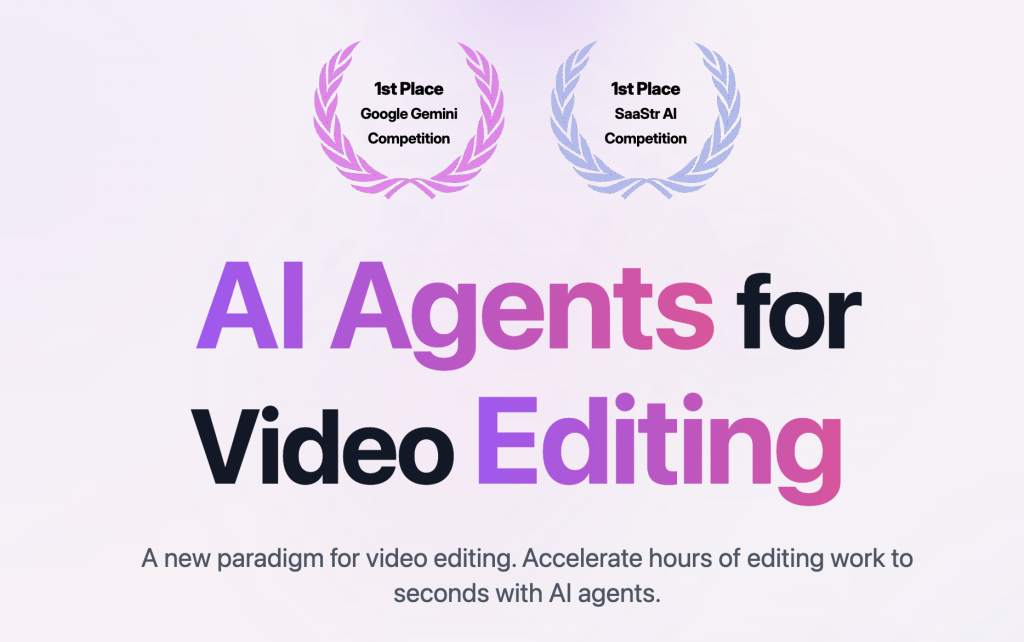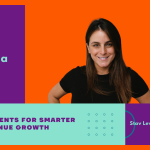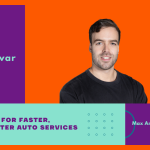Mosaic is reimagining video editing for the AI era. Founded by former Tesla engineers Adish Jain and Kyle Wade, Mosaic introduces a visual, agentic editing platform that empowers creators to automate complex edits and focus more on storytelling, cutting down hours of work into minutes.
1. What was the moment that sparked the idea for Mosaic, and how did your experience at Tesla shape your approach to building it?
Adish Jain: Kyle and I were both engineers at Tesla when one day we had an idea to make a YouTube video as a personal, creative endeavor. The idea was simple — we’d record cars going by in Palo Alto and for every Cybertruck we spot, we’d buy a share of Tesla stock.
It had all the makings of a viral video, but after recording, we came back to hours of raw footage of cars driving by. Now we’d have to scrub through this entire raw footage to see where the Cybertrucks appear and update the counter in the video.
As we began editing, we experienced firsthand the frustration of trying to accomplish simple tasks in traditional video editors like DaVinci Resolve and Adobe Premiere Pro. Features are hidden behind menus, buttons, and icons, and we often found ourselves Googling or asking ChatGPT how to do certain edits.
We thought that with the recent advancements in multimodal AI, we could accelerate some of this process. And better yet, if the multimodal AI is built into your video editor, it could automatically apply edits based on what it sees and hears in your video. The idea quickly snowballed and we started our side quest to build the Cursor for Video Editing.
2. Traditional video editing is time-consuming and complex. How does Mosaic’s agentic approach change the game for creators?
Adish Jain: Mosaic’s visual canvas enables creators to craft and run their own multimodal video editing agents.
For creators, this means they can build an agent once (or choose from one of our existing templates) and reuse it across projects. It also means that creators can 10x their content creation because our agents run the edit on autopilot.
Instead of spending hours dealing with complex editing software and manual editing tasks, creators can focus more on being the creative director of their video edit.

3. Mosaic allows users to build custom video editing agents. What’s the biggest advantage of this compared to existing AI-assisted tools?
Adish Jain: AI video editing tools today all do the same 5-10 different things — cut out silences, remove filler words, add captions. Because our agent is multimodal, such tasks become just a subset of what it can do. Based on what it sees or hears in your video, our agent can perform intelligent edits instead of out-of-the-box automations.
Mosaic’s canvas centralizes the latest creative AI tools. These become the building blocks with which you can create your own video editing agent. This means no more fragmented workflows, where you have to go to different AI tools to create different assets and then try and stitch them all together. Instead, Mosaic consolidates them all into one canvas and enables you to build intelligent editing automations on top of them.
4. What are the most common pain points video editors face today, and how does Mosaic address them?
Adish Jain: Video editing is in the critical path of every video going from conception to upload.
However, for beginners, the traditional video editor can be quite daunting — with endless menus, buttons, and icons presenting a steep learning curve. Our canvas-based approach is simple, opinionated, and intuitive.
On the other hand, for creators, teams, and agencies that want to put out lots of content quickly and A/B test different versions, this can be a time-consuming process with a lot of manual steps. Our workflow builder makes it so these manual steps can be easily automated and run on autopilot.
5. Can you share a real-world example where Mosaic significantly reduced video editing time for a creator or company?
Adish Jain: “We’ve been looking for a tool like Mosaic for months. Editing is generally extremely tedious and annoying. Mosaic makes it easy and pain free.” — Alex Steele, CEO of Opal
6. Many AI-powered editing tools exist, but Mosaic introduces a node-based agentic workflow. What makes this approach superior?
Adish Jain: Instead of tacking AI into the traditional video editor UI, Mosaic’s node-based approach rethinks the non-linear editor completely. This agentic approach allows you to trigger chains of video edits and even run multiple edits simultaneously — generating many versions of your video on autopilot. The ability to create these different variants enables the agent to A/B test on social platforms and learn from engagement data to self-improve.
7. As AI video generation advances, where do you see the balance between AI automation and human creativity?
Adish Jain: We have a strong conviction that the human need for creative expression will never go away. Rather, as AI starts to complete more of the basic tasks and jobs, people will have more time for this creative expression. We believe that AI automation — and in particular video generation — will play a supplemental role to this expression instead of overtaking it entirely.
8. You’re building for a broad audience—from indie creators to enterprises. How do you ensure Mosaic remains powerful yet easy to use?
Adish Jain: Mosaic is an extensible framework. The canvas — with its modular tiles — can go in a lot of different directions depending on the audiences we want to build for. However, we like to instead think in terms of use cases, which can subsequently apply to many different audiences.
The key to ensuring Mosaic remains powerful and easy to use is to initially optimize the framework for a particular use case, and then slowly expand our boundary set over time.
9. What has been the hardest challenge in scaling Mosaic, and how did you push through it?
Adish Jain: Mosaic is a deeply technical product and just building it out has been our biggest challenge so far. There have been a lot of technical hurdles to jump over in the past few months, like building our own video editor. We pushed through by navigating the idea maze quickly and grounding our decisions by constantly talking to and having fast iteration cycles.
10. Have you ever made a decision that went against conventional wisdom but turned out to be the right call?
Adish Jain: Due largely to ChatGPT and Cursor, the chat interface is one of the main paradigms for interacting with AI. When we started Mosaic, we followed this conventional wisdom and set out to build a chat copilot into the traditional video editor interface.
However, as we built this out and talked to users, we quickly realized some limitations that the chat UX presented. Really thinking from first principles allowed us to question the conventional wisdom of both the chat interface and even the traditional non-linear video editor. The result was the agentic node-based canvas. We feel that this is the right call, and people seem to be resonating with this new direction.
11. Looking ahead, where do you see Mosaic in 5–10 years?
Adish Jain: The long-term vision of Mosaic is to build the A.R.G.O. (A Really Good Opinionated) agent — an agent that has creative taste and performs real-time edits to your video. The A.R.G.O. agent will help you create content seamlessly, from conception to distribution.
12. What does a typical day look like for you as a founder, and what keeps you motivated?
Adish Jain: With our initial prototype of Mosaic, our chat copilot could only add text overlays based on what it saw or heard in the video. There was an interaction we captured in our logs from one of our early prototype users which really blew us away. The user had a video of a dog playing in their backyard and prompted our copilot to “Make the dog glow.”
Despite being initially programmed to add only text overlays, the AI copilot creatively interpreted the request. It devised a method to simulate a glow effect using yellow text elements and strategically placing them around the dog.
This was a really mind-blowing interaction for us. The AI took the ruleset that it was given, interpreted the user’s intent, and demonstrated an understanding beyond its explicit instructions to infer new editing techniques.
This was a glimpse into the future of agentic video editing. We hold onto this moment dearly, and it motivates us every day. A typical day in the life varies a lot, but mostly focuses on either building product, strategizing, or talking to users. I also make sure to take some time every day to go on walks with my dog. The fresh air and long walks are when the best ideas come to mind.
Editor’s Note
Adish Jain’s journey with Mosaic shows how firsthand frustration can fuel true innovation. In this interview, he shares how Mosaic’s agent-based, multimodal editing approach is setting a new standard for creators looking to move faster and stay creative.
You can browse all our AI founder interviews. Looking for upcoming AI conferences? Visit our AI Events Calendar.
Explore more AI founder stories
- Borja Díaz-Roig on Why UX Breaks When Validation Is Too Slow | Interview
- Tomo Tagami on Why DeFi Breaks at Execution | Interview
- Javier Saldana on Why Energy Transition Fails After Generation | Interview


